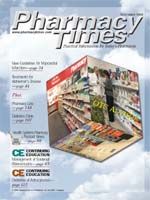Publication
Article
Pharmacy Times
Pharmacotherapy of Osteoporosis
Author(s):
Osteoporosis is a systemicskeletal disease characterizedby low bone mass andmicroarchitectural deteriorationof bone tissue, leading toincreased bone fragility andfracture. Bone remodelingoccurs throughout an individual'slifetime. In normaladults, the activity of osteoclasts(bone resorption) balancesthat of osteoblasts(bone formation), with peakbone mass occurring in theearly-to-mid 30s. Several prescriptionmedications are currentlyapproved for the preventionand/or treatment ofosteoporosis (Table). A discussionof these agents follows.
Bisphosphonates
Bisphosphonates are syntheticanalogs of naturallyoccurring hydroxyapatites(bone resorption inhibitors).They are considered first-linetherapy for the preventionand treatment of osteoporosis.Two agents, alendronatesodium (Fosamax; Merck) and risedronatesodium, (Actonel; Procter &Gamble/Aventis) have been approvedby the FDA for both prevention andtreatment of osteoporosis. Theseagents have been shown to increasebone mineral density (BMD) as wellas to decrease the incidence of firstand future fractures.
Bisphosphonates have poor oralbioavailability and can be corrosive tothe upper gastrointestinal (GI) tract.Strict administration guidelines mustbe followed in order to improveabsorption and avoid significantupper GI problems, such as nausea,stomach upset, and esophagitis. Bisphosphonatesmust be taken on anempty stomach with a full glass ofwater after getting up for the day.Patients also must be instructed towait at least 30 minutes before havingtheir first food, beverage, or othermedication for the day and to remainupright for at least 30 minutes aftertaking a bisphosphonate dose.
The safety of bisphosphonates overthe long term has been a subject ofinterest, and a study of alendronate(New England Journal of Medicine,March 2004) found that this agent wassafe over a 10-year period. The issue oflong-term use is important becauseosteoporosis is a chronic conditionrequiring long-term therapy. The optimumlength of therapy has yet to bedefinitively determined, however.
Estrogens
It is believed that 30% to 50% ofbone loss in older women is due toestrogen deficiency. If started soon aftermenopause, estrogen preventsthe accelerated phase of boneloss that occurs in the first 5years after the onset ofmenopause. To maintain thisbenefit, however, estrogenmust be continued on a long-termbasis, and recent studies(the Women's Health Initiative)have shown long-termestrogen therapy to be potentiallyunsafe. Although stillapproved for the preventionof osteoporosis, the FDA recommendsthat, when usedsolely for the purpose of osteoporosisprevention, nonestrogentreatments should be consideredfirst.
Selective Estrogen ReceptorModulators (SERMs)
Raloxifene hydrochloride(Evista; Lilly) is the only SERMcurrently approved for the preventionand treatment ofosteoporosis. SERMs demonstrateestrogen agonist activityat the bone and liver and antagonistactivity at the breast and uterus. Theseproperties result in increased BMD andreduced fracture risk without promotingbreast or endometrial cancer. Breasttenderness and vaginal bleeding also aredecreased, compared with estrogens.SERMs can, however, worsen hot flashes.They are contraindicated for pregnantwomen and for patients with a historyof thromboembolic disorders.
Calcitonin-Salmon
Calcitonin-salmon (Miacalcin;Novartis) is a hormone that inhibitsbone resorption. It is available as anasal spray or as an injection, thenasal spray being the most commonlyused formulation. It is approved forthe treatment of osteoporosis, andstudy results indicate increased spinalbone density and possible relief ofpain associated with spinal fractures.Therapy with calcitonin-salmonshould be reserved for postmenopausalwomen or women who cannottolerate other therapy. Side effects generallyare local reactions to the nasalspray.
Parathyroid Hormone
Teriparatide (Forteo; Lilly) is thenewest agent approved for the treatmentof osteoporosis, and it is the firstdrug to stimulate new bone growth. Itis available as an injection that containsrecombinant human parathyroidhormone. Teriparatide increases BMDand reduces the risk of vertebral andnonvertebral fractures; it is possiblymore effective than the other currentlyavailable therapies. Its use is currentlylimited by high cost and complexadministration and storagerequirements.
Patients should be cautioned aboutthe first dose effect?to sit or lie down ifdizziness or increased heart rate occursafter injection. Long-term safety also isquestionable due to the increased risk ofbone cancer in animal studies; therefore,teriparatide is currently not recommendedfor use for >2 years.
Calcium
Calcium should be considered animportant antiresorptive agent thatcan significantly enhance the action ofother treatment modalities. TheNational Institutes of Health recommends1000 mg of calcium daily foradult women 19 to 50 years old and1500 mg daily for those over 50 yearsold. For men, the recommendation is1000 mg of calcium daily for thoseunder 65 years old and 1500 mg dailyfor those over 65 years old.
The best source of calcium is dietarycalcium, although a variety of calciumsupplements are available to assistpatients in achieving their daily intake.The 2 most common forms of calciumsalts are calcium carbonate and calciumcitrate. Calcium carbonate has themost elemental calcium (40%), but itshould be taken with food to enhanceabsorption. Calcium citrate is absorbedin a nonacidic environment, so it canbe taken without regard to food andshould be recommended for patientson acid suppression therapy orpatients with achlorhydria. Calciumcitrate is only 20% elemental calcium,however, so an increased number oftablets may be needed to meet dailyrequirements. Regardless of the saltform, calcium is best absorbed whentaken in amounts of ≤500 mg at a time.
Adverse effects of calcium includeconstipation and drug interactions withiron, tetracycline, quinolone antibiotics,bisphosphonates, and phenytoin.It should be used cautiously in patientswith a history of kidney stones.
Vitamin D
Calcium is absorbed from the smallintestine and is utilized only in thepresence of vitamin D. Vitamin D alsoregulates serum calcium concentrationsby mobilizing calcium frombone. Vitamin D requirements varywith age, with 400 international unitsdaily recommended for patients aged51 to 70 years. Vitamin D can beobtained through fortified milk andexposure to sunlight. It also may befound as a dietary supplement, and itoften is included in a combinationproduct with calcium or in a multivitaminpreparation.
Dr. Singla is an assistant professor ofpharmacy practice at Midwestern UniversityCollege of Pharmacy?Glendale, Glendale,Ariz.
For a list of suggested reading, send astamped, self-addressed envelope to:References Department, Attn. A. Stahl,Pharmacy Times, 241 Forsgate Drive,Jamesburg, NJ 08831; or send an e-mailrequest to: [email protected].

Newsletter
Stay informed on drug updates, treatment guidelines, and pharmacy practice trends—subscribe to Pharmacy Times for weekly clinical insights.






